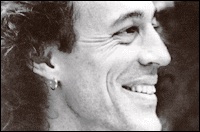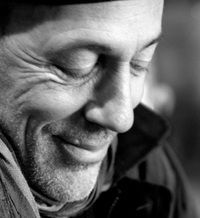Sw Shivam Sanjiva: Difference between revisions
(Created page with "218px|right (legal name?) Sanjiva was born in Québec in the late 50s, and began studying flute, piano and guitar at the age of six. His musical journe...") |
mNo edit summary |
||
| Line 1: | Line 1: | ||
[[image:Sanjiva.jpg | [[image:Sanjiva younger.jpg|right]] | ||
( | [[image:Sanjiva.jpg|right]] | ||
(Charles Roux) | |||
Sanjiva was born in Québec in the late 50s, and began studying flute, piano and guitar at the age of six. His musical journey went to a new level when the opportunity arose in high school to play on a pipe organ. This opened up vast possibilities of sonic experience, as did coming into contact with Indian music. He saw and felt how harmonics, modalities and tonalities could have a rich effect on the mind, mood and silence, understanding experientially how music and meditation were closely related. He learned to create spaces with music and silence. | Sanjiva was born in Québec in the late 50s, and began studying flute, piano and guitar at the age of six. His musical journey went to a new level when the opportunity arose in high school to play on a pipe organ. This opened up vast possibilities of sonic experience, as did coming into contact with Indian music. He saw and felt how harmonics, modalities and tonalities could have a rich effect on the mind, mood and silence, understanding experientially how music and meditation were closely related. He learned to create spaces with music and silence. | ||
| Line 9: | Line 11: | ||
Sanjiva came to Osho in 1982 and in 1986 moved to Poona, living there for 10 years. He played music in Darshan and meditations and was often the "sound man" at the mixer. Additionally, he worked with various therapists to create music supporting the therapeutic process. | Sanjiva came to Osho in 1982 and in 1986 moved to Poona, living there for 10 years. He played music in Darshan and meditations and was often the "sound man" at the mixer. Additionally, he worked with various therapists to create music supporting the therapeutic process. | ||
In 1989, at Osho's request, he composed ''The Secret of the Golden Flower'' the sound track to a Taoist meditation based on Osho's discourses in [[The Secret of Secrets]]. | In 1989, at Osho's request, he composed ''The Secret of the Golden Flower'', the sound track to a Taoist meditation based on Osho's discourses in ''[[The Secret of Secrets]]''. | ||
In 1991, his lifelong studies of sound were mature to a point where he began a two-year period of concentrated composing, resulting in 160 works, each resonating with a specific aspect of the human experience. | In 1991, his lifelong studies of sound were mature to a point where he began a two-year period of concentrated composing, resulting in 160 works, each resonating with a specific aspect of the human experience. | ||
| Line 46: | Line 48: | ||
;see also | ;see also | ||
[https://www.facebook.com/sanjivamusic|Sanjiva on Facebook] | :[https://www.facebook.com/sanjivamusic|Sanjiva on Facebook] | ||
[[category:Names|Sanjiva]] | [[category:Names|Sanjiva]] | ||
[[category:Québec (province)|Sanjiva]] | [[category:Québec (province)|Sanjiva]] | ||
[[category:Music - People|Sanjiva]] | [[category:Music - People|Sanjiva]] | ||
Revision as of 16:14, 14 April 2013


(Charles Roux)
Sanjiva was born in Québec in the late 50s, and began studying flute, piano and guitar at the age of six. His musical journey went to a new level when the opportunity arose in high school to play on a pipe organ. This opened up vast possibilities of sonic experience, as did coming into contact with Indian music. He saw and felt how harmonics, modalities and tonalities could have a rich effect on the mind, mood and silence, understanding experientially how music and meditation were closely related. He learned to create spaces with music and silence.
His research into sounds deepened by imbibing the Bardo Thodol, Gurdjief and Ouspensky, giving him a language and framework to formulate a broader understanding of the mathematical structures of music and the objective effect of sounds on the nervous system.
Sanjiva came to Osho in 1982 and in 1986 moved to Poona, living there for 10 years. He played music in Darshan and meditations and was often the "sound man" at the mixer. Additionally, he worked with various therapists to create music supporting the therapeutic process.
In 1989, at Osho's request, he composed The Secret of the Golden Flower, the sound track to a Taoist meditation based on Osho's discourses in The Secret of Secrets.
In 1991, his lifelong studies of sound were mature to a point where he began a two-year period of concentrated composing, resulting in 160 works, each resonating with a specific aspect of the human experience.
Starting in 1996, he released 6 Albums of electronica, on the Berlin Label Ninetysix Sounds.
Since 2002, he is in retreat, mainly focusing on meditation and meditation music, in particular deepening a study of the Kyotaku, a long shakuhachi used in meditation.
Contact Details
- a form on website
- website
- [1]
- discography
- xxxx : The journey (1st album for Ninetysix Sounds)
- xxxx : Origin (2nd album for Ninetysix Sounds)
- xxxx : Essence (3rd album for Ninetysix Sounds)
- xxxx : Initiation (4th album for Ninetysix Sounds)
- xxxx : Radiance (5th album for Ninetysix Sounds)
- 2013 : Mystica Organicum
- 2013 : Transparent
- 2013 : Neti Neti
- 2013 : The sun and the moon
- 2013 : Human anonymous
- 2013 : Meditation
- 2013 : Who is in?
- 2013 : Aqua
- + six "Atmosphere" ambient CDs
- videography
- [2]
- see also
- on Facebook
